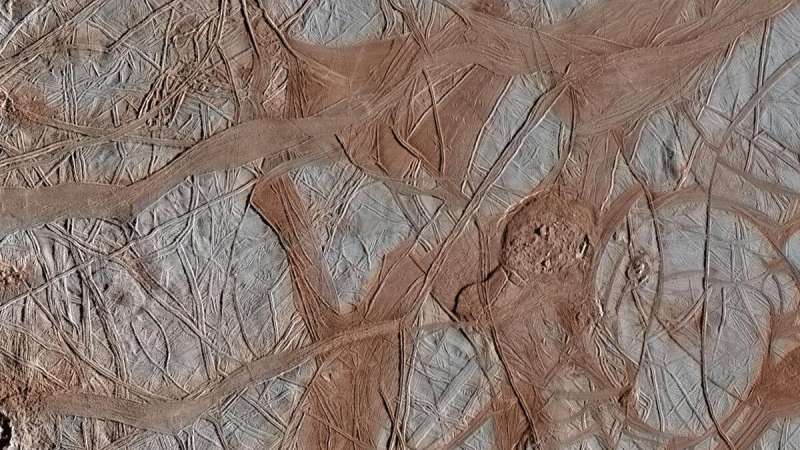Perhaps the best case for extraterrestrial plate tectonics is found in the floating ice shell of Jupiter's moon Europa.
Collins et al. provide the most comprehensive look yet at possible plate tectonic activity on Europa. They extended prior work to include more surface regions and a more sophisticated geometric approach, basing their analysis on a global map of Europa derived from images captured by NASA's Galileo orbiter.
The team identified prospective tectonic plates as regions of contiguous geography bounded by surface discontinuities. After identifying these boundaries, they inferred a time sequence of activity at the boundaries based on which discontinuities appear to lie atop or crosscut adjacent features. Once this sequence of events was established, they worked backward from the most recent event to reconstruct the likely motions of each plate needed to bring it into alignment with its neighbors.
The researchers applied this approach to three regions of Europa that they deemed most promising to have hosted past tectonic activity. They found that to best reconstruct the motion of the surface, large areas suspected to be plates in previous studies had to be broken into smaller subplates along less obvious boundaries. This observation helps explain why some prior studies found that large plates did not reconstruct well or behaved in other unexpected ways, the researchers note.
The authors draw four broad conclusions about plate tectonic activity on Europa: It is spatially widespread; it is regionally confined rather than globally connected; it occurs intermittently and is not happening now; and during past activity, plates drifted limited distances of between 10 and 100 kilometers.
Each of these traits distinguishes tectonic activity on Europa from that on Earth. The driving mechanisms for Europa's plate tectonic system are surely also different. To further reveal these mechanisms and to answer other questions about Europa, planetary scientists need more high-resolution observations, the researchers say, which the upcoming JUICE (Jupiter Icy Moons Explorer) and Europa Clipper missions will hopefully provide.
The work is published in the Journal of Geophysical Research: Planets.
More information: Geoffrey C. Collins et al, Episodic Plate Tectonics on Europa: Evidence for Widespread Patches of Mobile‐Lid Behavior in the Antijovian Hemisphere, Journal of Geophysical Research: Planets (2022). DOI: 10.1029/2022JE007492
Journal information:Journal of Geophysical Research: Planets
Provided by American Geophysical Union
This story is republished courtesy of Eos, hosted by the American Geophysical Union. Read the original story here.



